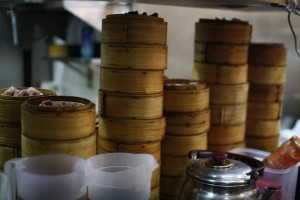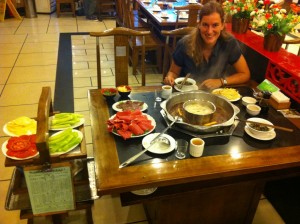 Six weeks in China have been quite a culinary experience. We weren’t adventurous enough to try things like turtle soup, grilled snakes or skewered scorpions, but we certainly tried a huge variety of Chinese food as we travelled across various provinces – it was amazing how different the flavours were in each area. So, here are some stories about the joys and frustrations of eating in China.
Six weeks in China have been quite a culinary experience. We weren’t adventurous enough to try things like turtle soup, grilled snakes or skewered scorpions, but we certainly tried a huge variety of Chinese food as we travelled across various provinces – it was amazing how different the flavours were in each area. So, here are some stories about the joys and frustrations of eating in China.
One thing you come across all over China are ‚baoz‘, steamed dumplings. As they are popular for breakfast , you see piles of small bamboo baskets filled with ‚baoz‘ (with steam rising from the bottom to the top of the pile) in front of every restaurant or street stall in the morning. Filled with either vegetables or meat, we loved them as a snack – even though the filling was usually a surprise, since we couldn’t read the menu… This was generally a challenge in China. Outside the big cities, it’s hard to find English menus in restaurants. That left us in many cases with three options. First option: just point at a random item in the menu and hope for the best. After a while we recognized the Chinese characters for rice, noodles and soup, so at least we could choose what category we are ordering from. It worked out better than we thought in most cases. Second option: use other people’s plates as a replacement menu, and order by pointing at whatever looks good. It would be weird in Europe to take a close look
, you see piles of small bamboo baskets filled with ‚baoz‘ (with steam rising from the bottom to the top of the pile) in front of every restaurant or street stall in the morning. Filled with either vegetables or meat, we loved them as a snack – even though the filling was usually a surprise, since we couldn’t read the menu… This was generally a challenge in China. Outside the big cities, it’s hard to find English menus in restaurants. That left us in many cases with three options. First option: just point at a random item in the menu and hope for the best. After a while we recognized the Chinese characters for rice, noodles and soup, so at least we could choose what category we are ordering from. It worked out better than we thought in most cases. Second option: use other people’s plates as a replacement menu, and order by pointing at whatever looks good. It would be weird in Europe to take a close look  at other people’s dishes, but it is totally acceptable here. People miss a sense of personal space anyway. Third option: spend hours trying to decode the Chinese writing with the help of the language section in the Lonely Planet. You might starve in the process but it’s the most risk-free approach.
at other people’s dishes, but it is totally acceptable here. People miss a sense of personal space anyway. Third option: spend hours trying to decode the Chinese writing with the help of the language section in the Lonely Planet. You might starve in the process but it’s the most risk-free approach.
Sometimes, the friendly restaurant owners actually made the effort to ‚translate‘ their menu. This enables you to order dishes like „linked to blood“, „refreshing ear wire“ or „soup smell of urine“. I am not kidding.
 Another peculiar thing is the spiciness of Chinese food. I never thought of Chinese food as being particularly spicy (I guess the stuff you get outside China is catering for Westerners that can’t handle chili so well). However, especially in Sichuan province and Chongqing, the food is so spicy it makes your eyes water. In addition to the conventional chili they use the so-called Sichuan pepper. It numbs your tongue, which is quite helpful so you don’t feel the pain inflicted on you by the overdose of chili – a weird sensation anyway. A local specialty there is hotpot, a kind of Chinese fondue. You have a pot with super-spicy broth in the middle of the table, and boil various meats and vegetables in it. It’s all done with chopsticks – so to retrieve your food from the boiling sea of chilis can be challenging, but it was great fun!
Another peculiar thing is the spiciness of Chinese food. I never thought of Chinese food as being particularly spicy (I guess the stuff you get outside China is catering for Westerners that can’t handle chili so well). However, especially in Sichuan province and Chongqing, the food is so spicy it makes your eyes water. In addition to the conventional chili they use the so-called Sichuan pepper. It numbs your tongue, which is quite helpful so you don’t feel the pain inflicted on you by the overdose of chili – a weird sensation anyway. A local specialty there is hotpot, a kind of Chinese fondue. You have a pot with super-spicy broth in the middle of the table, and boil various meats and vegetables in it. It’s all done with chopsticks – so to retrieve your food from the boiling sea of chilis can be challenging, but it was great fun!
Generally, there were always loads of tasty fresh vegetables (what a change from Mongolia!) that were  never overcooked. Meat was a different story. Sometimes we got lucky and were served filet-like pieces of meat, but more often than not ‚meat‘ meant animals chopped into pieces, and all pieces end up in your soup.
never overcooked. Meat was a different story. Sometimes we got lucky and were served filet-like pieces of meat, but more often than not ‚meat‘ meant animals chopped into pieces, and all pieces end up in your soup.
But we had many dishes we really loved. Naxi grilled meat marinated with ginger and melissa in Ljiang. Guilin noodles with peanuts and bamboo shoots. Cold noodles with sesame sauce in Xian. Peking duck pizza in Beijing. Wonton soup that reminded us of „Maultaschensuppe“ in Chongqing. Rice cakes. Crepes with Hoisin sauce. Langzhou hand-pulled noodles.
 But this food post can’t end without mentioning the real Chinese national dish: instant noodles. On train journeys, everyone lives seemingly exclusively on these noodle soups. It’s convenient, cheap and yet unbelievable
But this food post can’t end without mentioning the real Chinese national dish: instant noodles. On train journeys, everyone lives seemingly exclusively on these noodle soups. It’s convenient, cheap and yet unbelievable what quantities of them are consumed. There is no question what food you bring on the train – it’s just which one of the myriad of flavours on offer is your favorite.
what quantities of them are consumed. There is no question what food you bring on the train – it’s just which one of the myriad of flavours on offer is your favorite.
Oh, and if you really need a break from all this Chinese food – there is always a McDonalds around the corner.




One Response to Of dumplings and hotpots